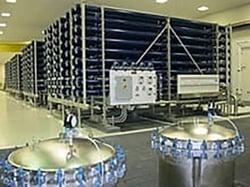 Do you need to remove or increase your reverse osmosis system's hydrogen sulfide removal efficiency?
Do you need to remove or increase your reverse osmosis system's hydrogen sulfide removal efficiency?
The industrial water treatment market has many forms of water treatment processes. Most of us would agree that maintaining high water standards and quality requires using multiple treatment systems to achieve results. Let’s face it, we do not win or get a “that a boy” when we design and build the best reverse osmosis system.
When we turn the brand-new water system on, the water has a "rotten egg odor." Yes, that is an embarrassing moment!
The problem is we typically design around what we can see or read. When was the last time you reviewed a water sample that provided details of how much-dissolved gas was in the water? Most likely never. A typical water treatment system may deploy reverse osmosis as the primary treatment method, and why true RO will remove particles that have size and weight (ions and molecules) typically defined as a certain size (micron), but RO does nothing to remove the dissolved gases that are already entrained within the water naturally or were created by adjusting the pH.
The need to protect the RO membrane from fouling or scaling can create the dissolved gases in the water that give you that “rotten egg odor” or hydrogen sulfide gas odor. So one treatment now creates the need for another!
When designing a degasification system for an industrial water application, you must first have good water test data from a certified testing laboratory. Identifying the presence of hydrogen sulfide in water (H2S in H2O) before the design and other harmful minerals that may cause scaling will enable you to predict whether or not adding a degasification tower is needed to remove the hydrogen sulfide dissolved gases. In addition, this may provide insight into whether or not you will need a chemical or biological scrubber for the off-gases after the degasification or decarbonation process. Also, it would be nice to have a crystal ball that could predict how fast the RO membranes may foul or scale I have never had the opportunity to see one, but it is important to try to maximize and improve the CO2 efficiency removal because the extra effort may save your Ion exchange resin and will no doubt extend the life between regeneration cycle which will reduce O&M costs.
I have learned from the old fashion “School of hard knocks".
Learning the key to designing a good industrial water treatment system is admitting that none of us understand everything there is to know about water treatment. Let’s face it, how many times have we all had an “ah ha” moment on a job? Yes, having a strong background in water chemistry is good, but most top-notch water design professionals learn from the school of hard knocks and making mistakes and fixing them later. Always take the time, obtain good upfront water analysis data, and understand what the water has in it and the water Langelier index (LSI). These and other variables will allow a design professional or design manufacturer to properly size and select the maximum efficiency treatment process and what additional pieces are required, like a Decarbonation or a Degasification tower, to be added into the process to remove dissolved gases such as Hydrogen Sulfide and Carbon Dioxide. And remember, there is a direct relation between removal efficiency and pH and temperature when you are designing a water process system. If the pH of the water to be treated is 7.0 or higher, it is unlikely you will achieve removal efficiencies above 90% in a degasification tower intended to remove Hydrogen Sulfide. However, as the inlet water pH moves more acidic to a perfect 5.5 pH, you can achieve a removal efficiency of 99.999%. Last, don’t forget now that you have maximized the removal of Hydrogen sulfide gases from your reverse osmosis process, the degasification tower should also serve as a “decarbonator” to remove carbon dioxide and naturally raise the pH without the use of chemicals. So maximizing the design and selection of the distribution system should be key to ensuring high removal and hydraulic load distribution across the media bed of the tower. At DeLoach Industries, inc., we maximize the removal efficiency of en-trained gases right from the point of entry into our towers. For more information on your water treatment needs, contact the professionals at DeLoach Industries, Inc at (941) 371-4995.




